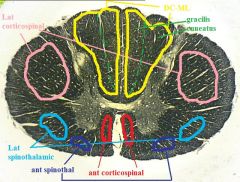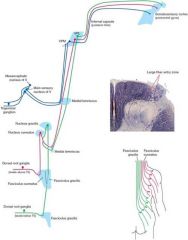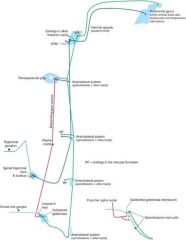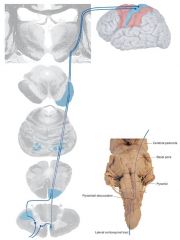![]()
![]()
![]()
Use LEFT and RIGHT arrow keys to navigate between flashcards;
Use UP and DOWN arrow keys to flip the card;
H to show hint;
A reads text to speech;
30 Cards in this Set
- Front
- Back
|
the dorsal root ganglion neurons that synapse in the dorsal horn are part of a circuit for protective senses like
|
pain, temp, itch
|
|
|
the dorsal root ganglion neurons that branch in the white matter enter the _______.these transmit to the brainstem sensory info about touch and proprioception
what is this system called? |
dorsal column
dorsal column-medial lemniscal system |
|
|
The posterior column is involved in the dorsal column-medial lemniscus (DC -ML) tract. This tract carries ascending sensory fibers mediating ____________
an important landmark for DC-ML is ____ This is because below this, we only are gathering sensation fibers for the lower limbs (after all, the arms don't exist at and below the lower thoracic level). So, the posterior column BELOW T6 consists ONLY of the fasciculus gracilis. Once we hit T6, we start to get sensory fibers for the upper limbs, so we can now add in the fasciculus cuneatus. But, of course, we don't LOSE the gracilis fibers, since everything is heading for the cerebral cortex. So, the posterior (or dorsal) column keeps getting bigger, and, rostral to T6, we now divide it (on the left and right sides each) into two sections -- gracilis and cuneatus. |
fine touch and proprioception
T6 |
|

what's the anterior corticospinal tract?
|
its the corticospinal fibers that don't decussate
|
|
|
corticospinal fibers are involved in motor control, and therefore, are a ______ tract. The signal originates in the primary motor cortex and is transmitted to the spinal cord; the tract decussates at the pyramids of the medulla and the signal continues to the cord through the __________
The UMN then synapses in the ventral horn of the cord (at a given level, depending on what muscle group you are telling your brain to move) and now the signal is picked up by the ______ |
descending
upper motor neuron lower motor neuron (LMN; a post-synaptic neuron, a peripheral nerve). |
|
|
the corticospinal tract is actually two tracts:
1. the lateral corticospinal tract, located in the lateral funiculus of the cord. This makes up 85% of the corticospinal tract fibers, and decussates in the medulla at the _________ 2. the anterior corticospinal tract, located anteriorly in the anterior funiculus. does not decussate until in the cord itself, or does not cross at all (some fibers supply motor control to ipsilateral muscle groups). |
pyramids
|
|
|
Substantia gelatinosa (a nucleus of neurons)
- lightly myelinated and unmyelinated neurons - relays mainly __________ |
pain +temp info
|
|
|
Clarke’s nucleus
- distinctive region between _____ - relays information from lower limbs to _____ |
T1-L2
cerebellum |
|
|
for the Spinothalamic Tract (STT) where do the fibers decussate?
and then where do they go? what info does it carry? |
at spinal level of entry...they decussate IMMEDIATELY...
to thalamus (ventral posterolateral nucleus VPL) (there's also branches that go to the periaqueductal gray in the midbrain) pain + temp The Trigeminal's involvement in the anterolateral/spinothalamic system: central processes of trigeminal ganglion cells go down the spinal trigeminal tract to caudal parts of the trigeminal nucleus) (the trigeminal pain + temp fibers got to VPM) axons of these 2nd order neurons cross the midline and join the somatotopically appropiate region of the spinothalamic tract, and ascend to VPM of the thalamus!! (note that trigeminal pain + temp goes to VPM, and that the rest of the anterolateral system (mostly spinothalamic) goes to VPL) |
|
|
How many neurons in the system?
Corticospinal Tract (CST): Spinothalamic Tract (STT): Dorsal Column - Medial Lemniscus Tract (DC-ML): |
Corticospinal Tract (CST): 2
Spinothalamic Tract (STT): 3 Dorsal Column - Medial Lemniscus Tract (DC-ML): 3 |
|
|
descending or ascending?
Corticospinal Tract (CST): Spinothalamic Tract (STT): Dorsal Column - Medial Lemniscus Tract (DC-ML): |
Corticospinal Tract (CST):desc
Spinothalamic Tract (STT): asc Dorsal Column - Medial Lemniscus Tract (DC-ML): asc |
|
|
what are the 1st and 2nd order neurons called of the CST tract?
|
UMN, LMN
|
|
|
Most UMNs (of CST) decussate at spinomedullary jxn/caudal medulla as _____
|
pyramidal decussation
|
|
|
in STT, 2nd order neuron decussates at spinal cord level at
|
anterior white commissure
(the little strip posterior to the gray matter in the middle of the spinal cord) |
|
|
in DC-ML, 2 order neuron decussates in caudal medulla as
|
internal arcuate fibers
|
|
|
primary afferent axons from dorsal root ganglia
stay on the same side where they came(are ipsilateral) project to 1 of 2 places: |
- synapse with relay neurons in gray matter of spinal cord and/or
- ascend and synapse with medullary relay neurons |
|

DC-ML system
Mediates fine touch, proprioception and vibration Ascends in dorsal columns (Fasciculus ____ and Fascicululs ____) Synapses in Nucleus Gracilis and Nucleus Cuneatus 2nd-order neuron decussates (CROSSES OVER) in the _________ Courses through the medial lemniscus to the ______of the thalamus Synapse in the thalamus, then project through internal capsule to primary somatosensory cortex (S1) Synapses in S1 |
Fasciculus Gracilis and Fascicululs Cuneatus)
internal arcuate fibers VPM/VPL nuclei |
|

STT:
Mediates temperature, pain, and gross touch Synapses within dorsal gray matter of spinal cord (substantia gelatinosa) near entry level 2nd order neurons (IMMEDIATELY) decussate in the _______ Fibers run rostrally (toward the head) in the spinothalamic tract Synapse in VPM/VPL nuclei of the thalamus 3rd-order neurons project through the internal capsule to S1 |
anterior white commissure
|
|

CS tract
Descending motor control 1st order neuron is from layer ____ of Primary Motor Cortex (M1) Fibers course caudally (towards the tail) through the internal capsule, into the cerebral peduncles, the corticospinal tract in the basal pons, and the pyramids. Most 1st order fibers decussate in the pyramidal decussation. Run caudally in the lateral corticospinal tract |

5
|
|
|
proprioception-stereognosis has a conscious and an unconcious component.
the conscious pathway, connects with the thalamus and cerebral cortex the unconscious pathway connects with the cerebellum (an "unconscious organ") as the ___________ |
spinocerebellar pathway
|
|
|
unlike the other sensory pathways which cross contralaterally, the_______ stays on the same side
(it's the one that controlls unconscious proprioception) |
spinocerebellar
|
|
|
t/f
upper motor neurons (of the corticospinal tract) are 2nd order neurons |
false!
they're first order |
|
|
a hemisection of the spinal cord at the level of T1 actually produces contralateral loss of pain-temp sensation of T3 and below, rather than at T1 and below. Why?
|
pain-temp fibers do not ALL cross over immediately ...many ascend 1, 2 segments before crossing over
if this doesn't make sense to you, draw out fibers coming in at T1, T2, T3 levels |
|
|
the pain-temp fibers in the spinothalamic tract are arranged so that Leg fibers are lateral to Arm fibers. ...a tumor pressing in from outside the cord may affect the ______ extremitis fibers first
|
low
|
|
|
at what level--peripheral nerve, spinal cord, or above---would you expect a lesion to lie, with the following sign:
sensory loss along a give dermatome, unilaterally |
peripheral nerve or its entry point into the spinal cord
(unlikely that a SINGLE dermotome is affected with lesions elsewhere) |
|
|
at what level--peripheral nerve, spinal cord, or above---would you expect a lesion to lie, with the following sign:
bilateral sensory loss in the hands or feet |
peripheral neuropathy
(commonly of metabolic etiology...diabetes or alcoholism...resulting in selective involvement these regions) |
|
|
at what level--peripheral nerve, spinal cord, or above---would you expect a lesion to lie, with the following sign:
loss of pain-temp sense on the left side of the body below the neck, and paralysis and loss of proprioception-stereognosis below the neck on the right |
hemisection of the right cervical cord
|
|
|
a patient with a tumor experiences loss of pain-temp in the left lower extremity followed by spastic paralysis on the right? where's the tumor?
|
in the right anterolateral aspect of the cord, compressing first the right spinothalamic tract and then enlargin to involve the coricospinal tract
|
|
|
_____________ are the axons of second-order neurons contained within the gracile and cuneate nuclei of the medulla oblongata.
These fibers cross (decussate) from one side of the medulla to the other to form the medial lemniscus. |
internal arcuate fibers
|
|
|
For the motor pathway, which neuron decussates? Where?
Where does the 2nd order neuron synapse with the 3rd order neuron in the spinalthalamic tract? Where does the cell body of the 1st order neuron for the DC-ML tract sit? What is the most likely deficit in an individual who suffers damage to their posterior spinal artery? |
For the motor pathway, which neuron decussates? Where?
UMN at the Pyramidal decussation (level of the Caudal Medulla) Where does the 2nd order neuron synapse with the 3rd order neuron in the spinalthalamic tract? VPL (Thalamus) Where does the cell body of the 1st order neuron for the DC-ML tract sit? DORSAL ROOT GANGLION What is the most likely deficit in an individual who suffers damage to their posterior spinal artery? Damage to the DC-ML resulting in loss of fine touch and proprioception (that is ipsilateral to the side of posterior spinal artery lesion) |

